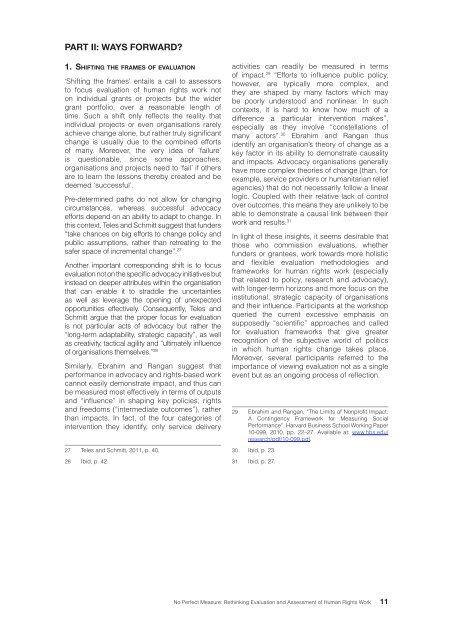No Perfect Measure: Rethinking Evaluation and ... - The ICHRP
No Perfect Measure: Rethinking Evaluation and ... - The ICHRP
No Perfect Measure: Rethinking Evaluation and ... - The ICHRP
Create successful ePaper yourself
Turn your PDF publications into a flip-book with our unique Google optimized e-Paper software.
PART II: WAYS FORWARD?<br />
1. Shifting the frames of evaluation<br />
‘Shifting the frames’ entails a call to assessors<br />
to focus evaluation of human rights work not<br />
on individual grants or projects but the wider<br />
grant portfolio, over a reasonable length of<br />
time. Such a shift only reflects the reality that<br />
individual projects or even organisations rarely<br />
achieve change alone, but rather truly significant<br />
change is usually due to the combined efforts<br />
of many. Moreover, the very idea of ‘failure’<br />
is questionable, since some approaches,<br />
organisations <strong>and</strong> projects need to ‘fail’ if others<br />
are to learn the lessons thereby created <strong>and</strong> be<br />
deemed ‘successful’.<br />
Pre-determined paths do not allow for changing<br />
circumstances, whereas successful advocacy<br />
efforts depend on an ability to adapt to change. In<br />
this context, Teles <strong>and</strong> Schmitt suggest that funders<br />
“take chances on big efforts to change policy <strong>and</strong><br />
public assumptions, rather than retreating to the<br />
safer space of incremental change”. 27<br />
Another important corresponding shift is to focus<br />
evaluation not on the specific advocacy initiatives but<br />
instead on deeper attributes within the organisation<br />
that can enable it to straddle the uncertainties<br />
as well as leverage the opening of unexpected<br />
opportunities effectively. Consequently, Teles <strong>and</strong><br />
Schmitt argue that the proper focus for evaluation<br />
is not particular acts of advocacy but rather the<br />
“long-term adaptability, strategic capacity”, as well<br />
as creativity, tactical agility <strong>and</strong> “ultimately influence<br />
of organisations themselves.” 28<br />
Similarly, Ebrahim <strong>and</strong> Rangan suggest that<br />
performance in advocacy <strong>and</strong> rights-based work<br />
cannot easily demonstrate impact, <strong>and</strong> thus can<br />
be measured most effectively in terms of outputs<br />
<strong>and</strong> “influence” in shaping key policies, rights<br />
<strong>and</strong> freedoms (“intermediate outcomes”), rather<br />
than impacts. In fact, of the four categories of<br />
intervention they identify, only service delivery<br />
27 Teles <strong>and</strong> Schmitt, 2011, p. 40.<br />
28 Ibid, p. 42.<br />
activities can readily be measured in terms<br />
of impact. 29 “Efforts to influence public policy,<br />
however, are typically more complex, <strong>and</strong><br />
they are shaped by many factors which may<br />
be poorly understood <strong>and</strong> nonlinear. In such<br />
contexts, it is hard to know how much of a<br />
difference a particular intervention makes”,<br />
especially as they involve “constellations of<br />
many actors”. 30 Ebrahim <strong>and</strong> Rangan thus<br />
identify an organisation’s theory of change as a<br />
key factor in its ability to demonstrate causality<br />
<strong>and</strong> impacts. Advocacy organisations generally<br />
have more complex theories of change (than, for<br />
example, service providers or humanitarian relief<br />
agencies) that do not necessarily follow a linear<br />
logic. Coupled with their relative lack of control<br />
over outcomes, this means they are unlikely to be<br />
able to demonstrate a causal link between their<br />
work <strong>and</strong> results. 31<br />
In light of these insights, it seems desirable that<br />
those who commission evaluations, whether<br />
funders or grantees, work towards more holistic<br />
<strong>and</strong> flexible evaluation methodologies <strong>and</strong><br />
frameworks for human rights work (especially<br />
that related to policy, research <strong>and</strong> advocacy),<br />
with longer-term horizons <strong>and</strong> more focus on the<br />
institutional, strategic capacity of organisations<br />
<strong>and</strong> their influence. Participants at the workshop<br />
queried the current excessive emphasis on<br />
supposedly “scientific” approaches <strong>and</strong> called<br />
for evaluation frameworks that give greater<br />
recognition of the subjective world of politics<br />
in which human rights change takes place.<br />
Moreover, several participants referred to the<br />
importance of viewing evaluation not as a single<br />
event but as an ongoing process of reflection.<br />
29 Ebrahim <strong>and</strong> Rangan, “<strong>The</strong> Limits of <strong>No</strong>nprofit Impact:<br />
A Contingency Framework for Measuring Social<br />
Performance”, Harvard Business School Working Paper<br />
10-099, 2010, pp. 22–27. Available at: www.hbs.edu/<br />
research/pdf/10-099.pdf.<br />
30 Ibid, p. 23.<br />
31 Ibid, p. 27.<br />
<strong>No</strong> <strong>Perfect</strong> <strong>Measure</strong>: <strong>Rethinking</strong> <strong>Evaluation</strong> <strong>and</strong> Assessment of Human Rights Work 11

















